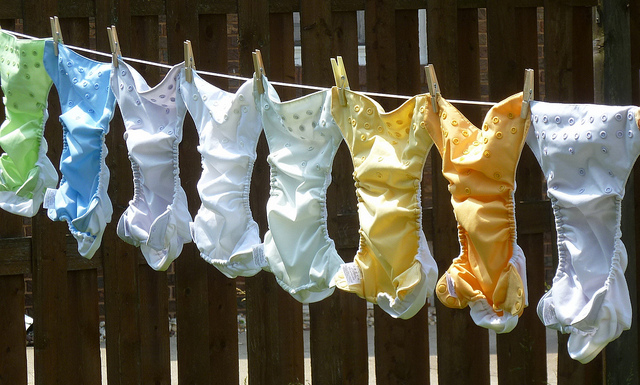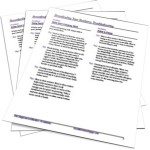
As parents, we know that changing our baby’s diaper often is important. We know that they’re prone to getting a little red as teeth erupt. And we know that cleaning well after each bowel movement is necessary to keep the rashes away. What if you’re changing promptly, even giving baby soothing soaks in the tub and some fresh air on their bum daily, and they STILL have rashes?
So many parents are unaware of the toxins that are present in their baby’s diapers. While some babies do fine with regular diapers, other babies are too sensitive, and a quick switch of diaper or wipes brands can make the difference.
1. Diapers and wipes with added scents, bleach, and toxic materials
If your baby only has a rash in her ‘diaper area’, what’s one of the first things we should look at? The diapers!
Disposable Diapers
Disposable diapers come in a variety of types. Some of the most popular, the ones you see advertised on TV and in parenting magazines, are known to contain:
- Dioxin (trace amounts from the bleaching process)
- Polyacrylic acid (the gel beads that make up the absorbent part of most diapers)
- BPA (part of the plastic)
These are some of the chemicals that babies may be sensitive to in disposable diapers. When a less toxic alternative is used, often diaper rash clears right up. Some babies do fine with a particular type of diaper for a while, and then they develop a sensitivity – this may be because the toxins have built up in their system, or the diaper manufacturer may have changed the materials slightly.
Some alternatives to Huggies, Pampers, and other mainstream brands:
I’ve used both of these brands with my children, and they do work well. More frequent changing is required, but it’s not excessive. I tend to change my babies right before nursing them.
- Naty Baby Care (plant-based materials. GMO free, oxygen bleached – not chlorine) I don’t think these have the gel beads in them, but I wasn’t able to confirm that.
- Nurtured by Nature (plant-based materials, oxygen bleached – not chlorine) I believe these have the gel beads in them, but there is enough of a barrier between the gel and my baby’s skin that they don’t come out through the diaper like other brands do (yuck).
With diapers, as well as all other things, be careful of ‘greenwashing’. Green washing is where a company heavily advertises some part of their product that is natural but in reality the product is not natural or healthy at all. Some mainstream brands have a ‘organic’ or ‘natural’ line, but they may only incorporate a very small amount of organic material in their diapers, so they really are not much better than the conventional brand.
Disposable Wipes
My children have reacted more to disposable wipes than they have to diapers. Because they are wet, wipes must contain some sort of preservative to prevent bacteria growth and mold. In addition to preservatives, most wipes are made out of chlorine bleached wood pulp, and have added fragrance.
Some chemicals found in mainstream wipes that bother babies:
- Dioxins, again, from the chlorine bleaching process
- Methylisothiazolinone (preservative)
- Phenoxyethanol (preservative)
- Fragrance (petroleum based)
Some natural alternatives:
- Naty baby wipes (these contain benzyl alcohol as the main preservative, which also can cause skin irritation, but it is naturally sourced and more environmentally friendly – these are what I use when I’m not using cloth)
- Cloth wipes – these aren’t as difficult to use as you might imagine. I just run them under warm water in the bathroom and then place in a wet bag until I do laundry.
Cloth Diapers
Cloth diapers aren’t all created equal either. Some babies get irritated by having the wet cloth against their skin, so they do better with a microfiber moisture barrier. Some babies are sensitive to the synthetic fiber in the microfiber and they do better with a diaper that only has cotton against their skin.
I use and recommend Grovia diapers, but there are many other great brands out there. If your baby is getting a rash despite frequent changing and they are in cloth diapers, I recommend checking to see what materials are up against baby’s skin and changing to a natural option if it’s a synthetic.
Grovia diapers come with an outer shell, and a snap in absorbent layer. You can also use a prefold in the shell as well.
- Grovia waterproof shells
- Grovia organic inserts (I recommend these unless your baby is bothered by them)
- Prefolds – high quality (these double as burpers – they’re quite handy to have around)
- Grovia stay dry inserts (contain synthetic materials)

Thankfully food sensitivities are often outgrown in the infant.
2. Food allergy
Food allergies or sensitivities can show up as diaper rash. Very sensitive babies can even be affected by what mom is eating, and they may get a rash on their bottom in connection to common allergens such as milk or wheat in the breastfeeding mother’s diet.
It’s more common for a baby to show a sensativity once he starts solids. Food passes through the immature digestive tract without being fully digested, and this can cause irritation when it comes out as poop.
Some common allergens that may be causing a diaper rash in your baby’s diet:
- Raw fruits and vegetables (cooked are easier to digest)
- Dairy
- Grains (including wheat, rice, oats, barley)
- Wheat
- Corn
The good news is that as the baby grows, his gut is maturing and sealing up, so if he’s getting a rash from a food during infancy, this doesn’t usually mean that it is a lifelong intolerance, but rather, is something he’ll grow out of. Probiotics for babies (we use these) can also help digest the food and seal the gut.
3. Yeast
Yeast is normally present and balanced in our gastrointestinal tract, but when it gets out of balance it can cause yeast infections. Yeast live in warm, moist places, so it can be difficult to get rid of a yeast infection diaper rash. If mom or baby has been on a round of antibiotics, as is common in the case of Group B Strep during delivery, they may both struggle with yeast infections. Yeast rash is something to be considered if after changing the type of diaper, changing soiled diapers promptly, and using zinc oxide cream, the baby still has a persistent or even worsening diaper rash.
A yeast rash may need advise of a doctor, please contact your doctor if you have any questions.
Some natural solutions for yeast rash:
- Green french clay can be used like powder and can stop the spread of yeast
- Kefir or yogurt has active beneficial bacteria in it. When applied to baby’s clean bottom, it can help re-establish a healthy flora balance ont he skin.

Get your free troubleshooting guide by clicking the button below
Free printable with causes and solutions!
Print this out and keep it near your changing table to remind you what to do if your little one develops a rash.
Click here to get your free printable by email
Do you know of a little one who’s prone to rashes? Share this and help their parents out!
Learn how to heal leaky gut

60-page ebook of all my best GAPS Diet (Gut and Psychology Syndrome) articles all in one place.


Hi, my elder daughter used to have some rash, she was wearing cloth diapers. Nothing helped until I started to double rinse the diapers after every washing in the machine. And that was it! The cause of the rash was the washing powder traces.